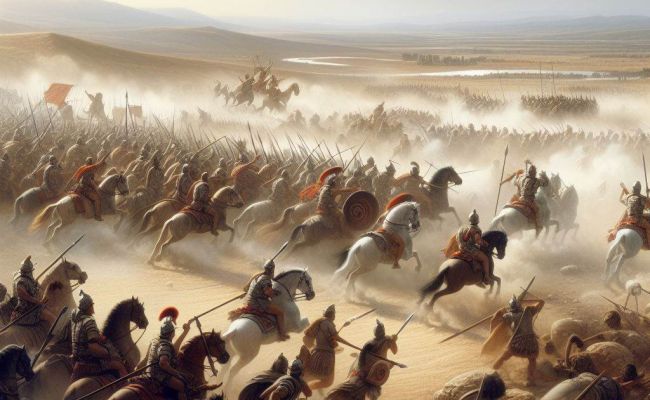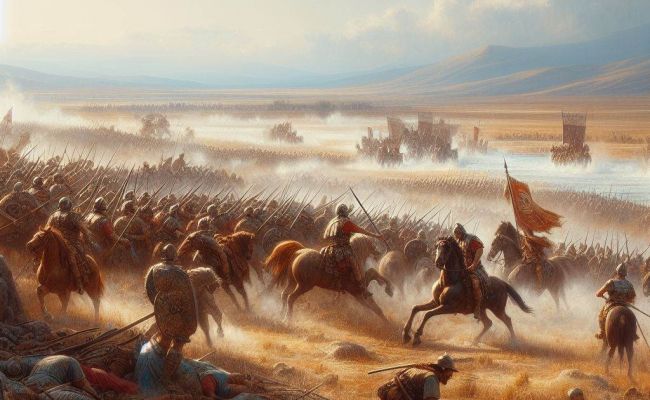The Battle of Cannae was an important conflict in the Second Punic War between the Roman Republic and Carthage. It took place on August 2, 216 BC, near the ancient settlement of Cannae in Apulia, southeast Italy. The Carthaginians and their allies, led by Hannibal, encircled and nearly destroyed a larger Roman and Italian army under consuls Lucius Aemilius Paullus and Gaius Terentius Varro. One of the greatest tactical triumphs in military history and one of the most humiliating defeats in Roman history, it solidified Hannibal’s reputation as one of antiquity’s finest tacticians.
After recovering from their defeats at Trebia (218 BC) and Lake Trasimene (217 BC), the Romans resolved to confront Hannibal at Cannae with an estimated 86,000 Roman and allied forces. The Romans massed their heavy troops in a deeper position than usual, and Hannibal used the double envelopment method to trap his opponent, ultimately leading to the slaughter of the majority of the Roman army. The loss of life on the Roman side made it one of the most lethal single days of battle in history; Adrian Goldsworthy compares the death toll at Cannae to “the massed slaughter of the British Army on the first day of the Somme offensive in 1916.” Only about 15,000 Romans survived, the majority of whom were from camp garrisons and had never participated in the war. Following their defeat, Capua and several other Italian city-states defected from the Roman Republic to Carthage.
When news of the defeat reached Rome, the city was in a state of terror. The authorities took extensive measures, such as scrutinizing the Sibylline Books, dispatching a team under Quintus Fabius Pictor to consult the Delphic oracle in Greece, and interring four individuals alive as offerings to their gods. To form two new legions, the authorities reduced the draft age and recruited criminals, creditors, and even slaves. Despite heavy losses in soldiers and equipment, as well as a second devastating defeat later that year at Silva Litana, the Romans refused to surrender to Hannibal. Hannibal abruptly rejected his offer to ransom the survivors. The Romans fought for another 14 years until they won the Battle of Zama.
Many considered the conflict a great Roman disaster. In contemporary times, Cannae has become legendary, often cited as an example of flawlessly defeating an enemy force.
Strategic background
In the summer and early fall of 218 BC, Hannibal traveled into Italy across the Pyrenees and Alps, shortly after the outbreak of the Second Punic War. He defeated the Romans decisively at Trebia and Lake Trasimene. Following these defeats, the Romans nominated Quintus Fabius Maximus Verrucosus as dictator to combat the menace.
Fabius engaged in attrition warfare against Hannibal, cutting off his supply lines and avoiding pitched engagements. These tactics were unpopular with the Romans, who, after recovering from the shock of Hannibal’s victory, began to question the wisdom of the Fabian plan, which had allowed the Carthaginian army to rebuild. The majority of Romans wanted the conflict to end quickly. We anticipated that if Hannibal continued to pillage Italy uncontested, Rome’s allies might desert to the Carthaginian side for survival.The battles of Trebia, Lake Trasimene, and Cannae are arranged anticlockwise from top to bottom.
As a result, the Senate declined to extend Fabius’ dictatorial powers when his term expired, delegating authority to consuls Gnaeus Servilius Geminus and Marcus Atilius Regulus. Gaius Terentius Varro and Lucius Aemilius Paullus led a newly recruited army of unprecedented size and faced Hannibal when elections resumed in 216 BC. Polybius wrote:
The Senate decided to send eight legions into battle, a first for Rome, with each legion consisting of 5,000 troops in addition to allies. One consul and two legions, each with their own quota of allies, determine the majority of their conflicts; they rarely use all four at the same time and for the same purpose. But on this occasion, they were so terrified of what would happen that they decided to send not just four but eight legions into battle.
Polybius’s Histories

Estimated Roman troop numbers
Every year, Rome hired four legions, each with 4,000 footmen and 200 cavalry. According to contemporary Roman sources, the Senate established eight legions, each with 5,000-foot soldiers and 300 cavalry, with allied troops totaling the same number of foot soldiers but 900 cavalry per legion—more than tripling the legion numbers. The heart of this vast new army consisted of eight legions, or approximately 40,000 Roman troops, and an estimated 2,400 cavalry. According to one version, the Romans increased their army by only 10,000 troops. While no exact number of Roman troops existed, all accounts agree that the Carthaginians confronted a much greater foe.
Roman command
The Senate assigned two of the four legions to each of the two consuls, creating an exceptional situation where all four legions were under the same command. However, the Senate feared a real threat and sent all eight legions to the field, including allies. Normally, the two consuls would command their respective portions of the army, but due to the unification of the two armies, Roman law required them to alternate command daily.
According to ancient accounts, Varro was in command on the day of the fight, and he bears much of the blame for the defeat. The records overstate his humble beginnings, potentially making Varro a scapegoat for the aristocratic establishment. He lacked the prominent offspring that Paullus had, descendants who were ready and able to safeguard his reputation—most notably his grandson Scipio Aemilianus, the patron of Polybius, one of the primary sources of this narrative.

Date
Ancient historians rarely give specific dates for the events they recount. For example, Livy does not provide exact dates for any of the Second Punic War conflicts. According to Macrobius, citing the Roman annalist Quintus Claudius Quadrigarius, the battle took place ante diem iiii nones Sextilis, or on August 2.
The months of the pre-Julian Roman calendar do not correlate to their namesake Julian day. Livy, for example, describes a moon eclipse in 168 BC as occurring on September 4, despite astronomical calculations indicating that it occurred on Julian Day 21 June of that year. This disparity was caused by the pontifices’ inability to correctly complete intercalations, whether by accident or for political gain. After reviewing the data, P.S. Derow determined that the comparable Julian date is July 1, 216 BC. Other authorities have provided alternative Julian dates.
Armies
Figures for troops involved in ancient conflicts are frequently inaccurate, and Cannae is no different. We should approach them cautiously, especially those on the Carthaginian side. The Carthaginian army was made up of fighters from various places and could have numbered between 40,000 and 50,000. An estimated 8,000 Libyans, 5,500 Gaetulians, 16,000 Gauls—primarily Boii and Insubres—and 8,000 Hispanic tribes, including Iberians, Celtiberians, and Lusitanians, made up their infantry.
Hannibal’s cavalry also hails from many backgrounds. He led 4,000 Numidian, 2,000 Iberian Peninsular, 4,000 Gallic, and 450 Libyan-Phoenician cavalry. Hannibal’s auxiliary skirmisher contingent consisted of 1,000–2,000 Balearic slingers and 6,000 javelin men of mixed nationalities, possibly including Lusitanians. The personal ties each faction had with Hannibal served as the unifying force for the Carthaginian army.
Casualties
According to Polybius, the Roman and allied infantry lost 70,000 lives, 10,000 were captured, and just “perhaps” 3,000 survived. He also states that just 370 of the 6,000 Roman and allied cavalry survived.
Livy said, “Forty-five thousand and five hundred foot, two thousand and seven hundred horse, with an equal number of citizens and allies, are said to have been slain.” He also claims that the Carthaginians captured 3,000 Roman and allied infantry and 1,500 Roman and allied cavalry. Another 2,000 Roman fugitives were apprehended at the unfortified settlement of Cannae by Carthaginian cavalry led by Carthalo, while 7,000 were imprisoned in the smaller Roman camp and 5,800 in the bigger. Although Livy does not name his source, it was likely Quintus Fabius Pictor, a Roman historian who fought in and wrote about the Second Punic War. Livy refers to a picture when reporting on the casualties in the Battle of Trebia.
In addition to the consul Paullus, Livy recorded that among the dead were 2 quaestors, 29 of the 48 military tribunes, some of the consular rank, including the consul of the previous year, Gnaeus Servilius Geminus, and the former Magister equitum, Marcus Minucius Rufus, and 80 “senators or men who had held offices which would have given them the right to be elected to the Senate”.
Later Roman and Greco-Roman historians mostly followed Livy’s figures. Appian reported 50,000 deaths and “a great many” taken prisoner.[80] According to Plutarch, “50,000 Romans fell in that battle… 4,000 were taken alive in the field and 10,000 in the camps of both consuls”.Quintilian: “60,000 men were slain by Hannibal at Cannae”.Eutropius wrote: “20 officers of consular and praetorian rank, 30 senators, and 300 others of noble descent, were taken or slain, as well as 40,000-foot-soldiers, and 3,500 horses”.
While some modern historians view Polybius’ figure as incorrect, they accept Livy’s. Other historians have come up with significantly lower estimations. In 1891, Cantalupi predicted Roman losses ranging from 10,500 to 16,000. In 1990, Samuels also thought Livy’s figure was substantially too high because the cavalry would have been insufficient to keep the Roman infantry from fleeing. He doubts Hannibal planned a high death toll, given that much of the army was made up of Italians whom Hannibal sought to win as friends.[85] Micheal Clodfelter also questions the Roman casualties, citing the scarcity and unreliability of ancient sources, stating, “Are we supposed to believe that Hannibal’s 50,000 Carthaginians slaughtered 48,000-70,000 Romans on a single afternoon on the field of Cannae, even if the battle did degenerate into a massacre in its final stages?”
